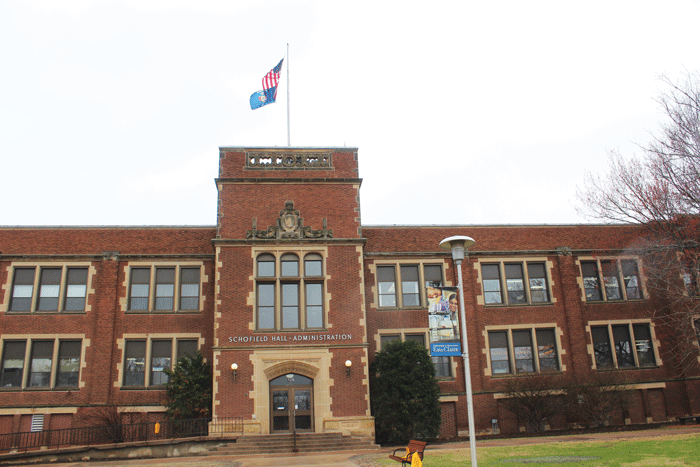Goodbye drafty windows, farewell leaky roof
Funding for renovations to two on-campus buildings approved last month by building commission
OLD MEETS NEW: Schofield Hall, the oldest building at UW-Eau Claire will get a facelift with plans to replace all 350 windows and four skylights. © 2014 Emily Albrent, The Spectator
April 30, 2014
Two buildings on campus will get a facelift as soon as next summer after The State Building Commission approved renovations earlier this month.
Schofield Hall, the oldest building at UW-Eau Claire, and McPhee Physical Education Center, originally built in 1969 and expanded in 1987, will receive $3.7 million in upgrades.
All of the repairs will be external. For Schofield, that means restoring the building, constructed in 1916, to a more classic look. The building last underwent renovations in 1976.
The plans propose to replace all of the 350 exterior windows, which University Project Coordinator Chris Hessel said were drafty. Plans also include replacing four skylights, all exterior doors and the north set of steps.
It will also repair damaged bricks and tuck-pointing between them on the exterior of the building.
The original wood-paneled windows were removed a long time ago, but the proposed replacements will be designed to look like the originals.
“Basically they will be thermally insulated windows with the historic look,” Hessel said. “The originals, but more energy efficient.”
After the windows are replaced, the upgrade will be completed by giving the building a “buff and polish” with a light pressure wash to take off the brown scum on the sandstone. Schofield’s repairs will account for about $2.3 million of the money approved by the commission.
The remaining $1.4 million in renovation money will go toward updating McPhee. Hessel said he has been working on getting these renovations approved and funded for five years, because he knew it was something that both Schofield and McPhee desperately needed.
McPhee’s repairs address the building’s envelope, mainly the roof and sidewalks around the exterior, Facilities Coordinator Troy Terhark said.
Terhark said because of how the sidewalks are structured, the water drains toward the building instead of running into sewers.
Wrong-way water flowage caused flooding on top of other issues, he said.
“A couple of summers ago when we had heavy downfalls of rain we had water leaking in to the building which later caused mold,” Terhark said. “At that time we let facilities know and they thought it was finally time to fix problems like the drainage around the building.”
Kim Wudi, athletic department staff and women’s volleyball head coach, said the leaky roof in McPhee caused problems when playing volleyball in the gym.
“We were hosting a club volleyball tournament when the snow was melting off of the roof last spring and we had to have someone sit in that area and wipe up the water,” Wudi said. “It was a safety issue and it could have caused serious damage to the floor.”
Wudi said while exterior upgrades, like a leaky roof, are harder to sell people on than aesthetic updates, they are eneeded for McPhee.
“Upgrades to the building that are long overdue need to be addressed because they can cause damage to other parts of the building and be a safety issue,” Wudi said.
Such large renovations could only be possible during the summer months, Hessel said. He is hopeful they will happen in 2015.

